
Part of the Series
Severed Ties: The Human Toll of Prisons
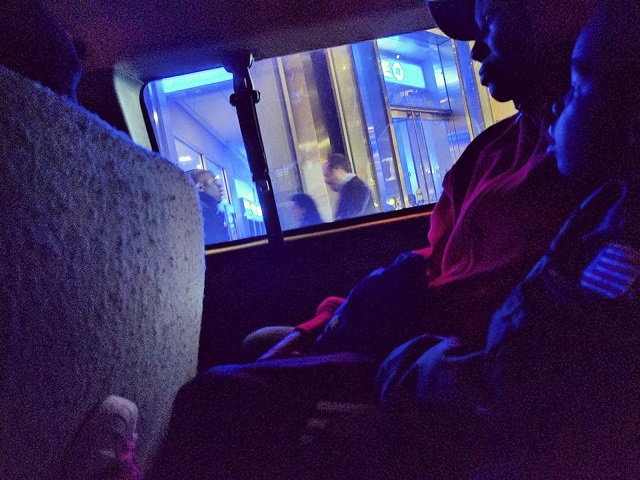 A woman and child sit in a van destined for upstate to a New York state correctional facility, as the van waits on last-minute passengers to board on May 12, 2017 in Manhattan, New York. Hundreds are visiting loved ones incarcerated in the state this weekend, Mother’s Day weekend. (Photo: Ese Olumhense)
A woman and child sit in a van destined for upstate to a New York state correctional facility, as the van waits on last-minute passengers to board on May 12, 2017 in Manhattan, New York. Hundreds are visiting loved ones incarcerated in the state this weekend, Mother’s Day weekend. (Photo: Ese Olumhense)
This story is the seventh piece in the Truthout series, Severed Ties: The Human Toll of Prisons. This series dives deeply into the impact of incarceration on families, loved ones and communities, demonstrating how the United States’ incarceration of more than 2 million people also harms many millions more — including 2.7 million children.
Most of the men in Carolyn Loveless’ family are (or have been) in prison. Currently, both of her sons are behind bars, as are her five nephews.
They are scattered in prisons across New York, from New York City, where most of the family is from, to Altona, a 15-minute drive from the US-Canada border, where one of Loveless’ sons is currently incarcerated.
Loveless, who first started visiting state prisons when she was 7, brought along by her grandmother to visit her grandfather upstate, still tries to visit almost everyone regularly, 40 years later.
Hardly any visits in recent memory, however, have been as special as the visit the 47-year-old left for on the night of Friday, May 12, she said. Two days before Mother’s Day, she was bound for Altona Correctional Facility to visit her son, currently incarcerated there.
“This is it,” Loveless told Truthout that night, as she waited for the 10 pm van picking her and about a dozen others up at 58th Street and 8th Avenue in Manhattan. “This is the Mother’s Day visit.”
The occasion is one of the more important ones for families hoping to see relatives on the inside. During a holiday weekend when one might assume most mothers in New York City are enjoying breakfast in bed, brunch or a much-needed break, hundreds of women and children like Loveless — almost all Black and Brown, and mostly low-income — board commercial buses and vans from pick-up points in Brooklyn, Manhattan and the Bronx, all headed to New York State Department of Corrections and Community Supervision (DOCCS) facilities upstate to see mothers, sons, daughters and other loved ones locked up hundreds of miles away.
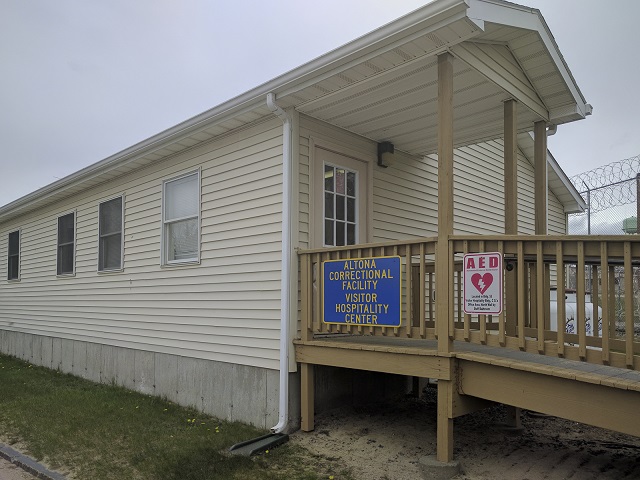 The visitor hospitality center at Altona Correctional Facility. Visitors check in here before proceeding into the facility and visit room. (Photo: Ese Olumhense)
The visitor hospitality center at Altona Correctional Facility. Visitors check in here before proceeding into the facility and visit room. (Photo: Ese Olumhense)
The long, taxing tours aren’t cheap. In 2011, after 38 years of operation, New York ended its free bussing program to upstate correctional facilities, leaving tens of thousands who relied on the monthly service without an affordable alternative.
A year later, in 2012, visits to upstate centers had fallen by more than 13,000.
Moves away from free bussing programs have played out similarly in other states, too. Last year, Illinois’ free bussing program was also eliminated, becoming what some criminal legal reform proponents dubbed “a victim to partisan budgetary politics.” Legal services advocates there later spearheaded a massive fundraising campaign to help children visit their incarcerated parents. More and more states, advocates told Truthout, are likely to abandon similar programs in their states, especially as video-visitation and other tele-visiting technologies are increasingly adopted.
Like in Illinois and elsewhere, New York State corrections officials maintained that the free buses, which up until 2011 had been funded through surcharges on prison phone calls, were not utilized enough to justify the $1.25 million annual cost. Additionally, they claimed, visitor totals fell little following the cancellation of the shuttle program, and some maximum-security prisons saw increases in visits.
At the time, a spokesperson acknowledged that, “Visitation is an extremely important part of an inmate’s rehabilitation and preparation for reentry.” The department further pledged to do “everything” it could to facilitate visitation in the absence of the free buses.
Nearly five years since that promise, however, DOCCS cannot assess whether or not those efforts have paid off. It claims it does not know whether visitors to its prisons have increased or decreased.
In response to a Freedom of Information Law request seeking the number of annual visitors at all DOCCS correctional facilities, DOCCS said it “does not track the number of inmate visitors nor maintain visitation records in a format that permits practical computation of annual statistics,” though state data on facility visits has been released to the public in the past.
Asked multiple times about the “missing” visitation data, more than one DOCCS staffer could not provide an answer — responses that confused some state criminal legal advocates, as well as the families and friends of some of those incarcerated in the state.
Though a DOCCS spokesperson told Truthout that the department hosts a number of special visitation events for families each year (more than 600 in 2016), it still claims it does not track visitor totals, leading some to question its strategy for funding so much of this programming without collecting the data needed to assess its impact. Others have expressed skepticism, questioning whether the claim may have been put forth to frustrate efforts to reinstate the free bus program.
Commercial Bussing: High Costs, High Risk
At least one proposal in the state legislature intends to reintroduce the free bus program. Assemblywoman Carmen De La Rosa, a new legislator and sponsor of the bill, believes reintroducing the shuttle service will help alleviate some of the financial anxiety surrounding visits for low-income families.
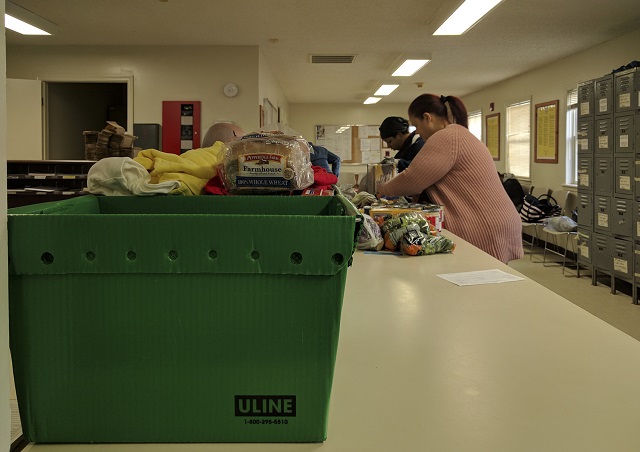 Visitors check in their commissary packages at Altona Correctional Facility, a medium-security facility in Altona, New York, on May 13, 2017. Each incarcerated individual in DOCCS facilities in the state is entitled to up to 35 pounds of goods each month. (Photo: Ese Olumhense)
Visitors check in their commissary packages at Altona Correctional Facility, a medium-security facility in Altona, New York, on May 13, 2017. Each incarcerated individual in DOCCS facilities in the state is entitled to up to 35 pounds of goods each month. (Photo: Ese Olumhense)
“It makes sense to have this be a free service in our state,” De La Rosa, a Democrat who is also on the assembly’s corrections committee, told Truthout. “It is the least that we can do for families who at times have lost lifetimes with a family member because that family member has committed a crime and is doing time. Those families are also doing the time as well.”
Presently though, the burden for transportation to these upstate facilities falls on the shoulders of some of the most marginalized people in the state, who now must find other ways of getting to their relatives and friends. De La Rosa says this situation leaves some of her constituents in the working-class New York City neighborhoods of Inwood, Washington Heights and Marble Hill “scraping by.”
“No one should be forced to pick between eating and providing their child that relationship,” she said.
After the bus service was cancelled, companies rushed to fill the void left in its absence. Depending on the destination, cash-only tickets can be purchased from fly-by-night operators with no listed phone number or address, for anywhere from $50 to $70 or more per person. (This expense is in addition to meals, commissary items and other goods needed for the trip.)
For families now leaning on one or no source of income, the lofty price of travel is a significant deterrent, but convenience and cost are not the only issues reported by families taking the trips.
Many of the companies making these long and demanding treks each weekend offer no proof of commercial driver’s licenses, some riders said, which would require them to comply with specific safety guidelines set by the Department of Motor Vehicles for commercial operators. Offering cheaper prices and door-to-door pick-up, some of these companies have attracted faithful flocks of desperate riders, while flouting safety measures like car seats for young children or maximum occupancy standards.
Further, buses and vans often break down, some travelers said, sometimes in the middle of the night, leaving families stranded for hours at frosty roadsides as they wait for replacement rides.
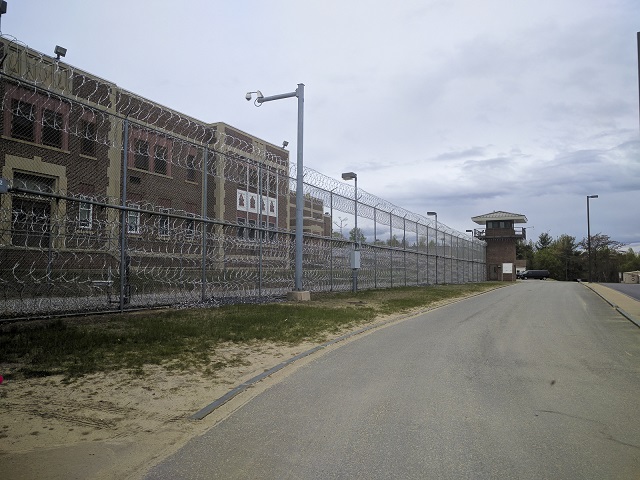 A view of Altona Correctional Facility in Altona, New York. (Photo: Ese Olumhense)
A view of Altona Correctional Facility in Altona, New York. (Photo: Ese Olumhense)
Just a few months ago, Loveless and her granddaughter spent a week stranded in the Albany area, after the 10 year old had an asthma attack while headed up to Altona to see her father. The driver, who works for Prison Gap, one of the oldest bus companies founded to serve New York City families with loved ones in prison, dropped them off to wait for an ambulance, Loveless says, and didn’t come back to pick them up (as promised) on the way back when the girl was discharged. Instead, Loveless had to wait for a relative to come pick her up the next week.
On a January trip, this time with Flamboyant Bus Service, the other leading bus company making the upstate tours, Bronx mother Gloria Castillo, 43, said the bus she and her three children were on, caught fire. Panicked, drowsy passengers rushed off, struggling to gather as many possessions as possible. Many reportedly still lost key documents, clothing, food and diapers. One woman reported losing $4,000 during the incident.
No rider in either of these incidents got their money back from the bus’s operators, Castillo and Loveless said. It’s rare that anyone does, a few travelers said, even when delays cost families a planned visit. Loveless didn’t get to see her son that weekend, and said Prison Gap refused to reimburse her for the portion of the trip she did not take.
Representatives from both Flamboyant and Prison Gap maintain that although accidents do happen, both companies work diligently to ensure passenger safety. When incidents happen that interfere with trips, representatives told Truthout, refunds are not usually given, but credits for future rides are. Both also pointed to the fact that no rider on either trip mentioned was seriously hurt, something they said speaks to the professionalism of both companies.
But, employees of both companies said, many of their newer competitors are operating with troubling disregard for safety. This, one employee said, is the result of “greedy” business practices.
“They don’t really care about the people, they just care about the money,” said an employee of Prison Gap, telling Truthout that he has been working in the transportation industry for 40 years. “They’re not treating people with respect, they just don’t care.”
Fearing that complaints could prompt retaliation from a bus company, many travelers said they have not filed formal complaints with state or city officials. For most, particularly those without access to a car, these buses and vans are the only ways of getting to the prisons they need to visit, and thus dictate when many can see family and friends, and how much it will cost them. In Loveless’s case, Prison Gap is the only bus company going to Altona on the weekends, so it’s her only option for getting to her son.
For those who huddled at the pick-up point at 58th and 8th in New York at the start of Mother’s Day weekend this May, these risks and hidden expenses are the necessary costs of visiting relatives and friends in lock up. For others, the long trip, its cost and the potential hazards have slowed visits to a halt.
Crumbling Support for Crucial Ties
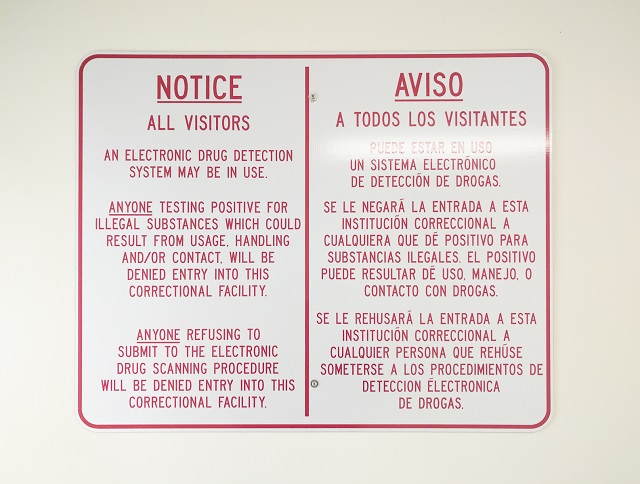 A sign hanging in the entrance to Altona’s visitor center lays out the rules for drug dectection scans at the facility. (Photo: Ese Olumhense)
A sign hanging in the entrance to Altona’s visitor center lays out the rules for drug dectection scans at the facility. (Photo: Ese Olumhense)
More than four decades of research shows that regular contact with family members through visits decreases recidivism and improves post-incarceration outcomes. One of the earliest tests of this theory, a 1972 study conducted by the California Department of Corrections, found that sustained family contact was a “major correctional technique.”
Researchers evaluated more than 800 incarcerated people in California, finding that incarcerated individuals who did not receive visitors (dubbed “loners”) were six times more likely to wind up back in prison during the first year.
“Visiting is crucial,” said Jack Beck, director of the Prison Visiting Project at the Correctional Association of New York, a nonprofit that advocates for criminal legal system reform. “It is, to me, one of the most essential elements of rehabilitation. You can’t expect people to come out and do well on the outside without having support. But that support you can’t expect to create itself once [the incarcerated person] leaves. It has to have been maintained while they are inside.”
Regular visits, Beck and other advocates agreed, are key to not only the safety and well-being of incarcerated people and the staff who regularly work with them, but also to children of incarcerated parents. The majority of people in the US’s prisons are parents of minor children, experts say, yet supportive policies and programs (like free shuttle services) that would encourage healthy parent-child ties once a parent is incarcerated are lacking.
“We’re taxing the poorest people to stay in contact with each other, and a lot of these costs fall disproportionately on women, who are the partners of incarcerated fathers,” said Lucius Couloute, policy associate at the Prison Policy Initiative. “But also, incarcerated women, who are most likely the primary caregivers in their families — they are trying to stay in touch with their kids. What is this doing to that relationship? It can’t be healthy. We know it can’t be healthy.”
The impact of this separation is staggering, research shows, and falls most heavily on children of color, who make up more than 70 percent of US children with incarcerated parents. Children who do not regularly visit their incarcerated parents fare worse on IQ tests and are more prone to self-esteem and behavioral issues than those who do.
Shantee Holloman fears her nephew’s 10-year-old son will suffer as a result of separation from his incarcerated father. This is why she brings the boy to Green Haven Correctional Facility, a maximum-security prison in Dutchess County, to see his dad once monthly. Her nephew was present for only the first year of his son’s life before being sentenced to 40 years for robbery, his first offense. Then he was 19. He’s now 29.
“He had just made it to [his son’s] first birthday, and that was it.” Holloman, 35, said, recalling the sentencing. “It’s so sad. This is why I try to keep him in contact with him. I don’t want him to forget him. I don’t think he would know who he is without this.”
More than once, the New York State Department of Corrections and Community Supervision has recognized the significance of maintaining family ties through visits. In its handbook, the department says, “Visitation by family and friends is encouraged,” and calls it a “positive influence” on an incarcerated individual’s time in prison. Dozens of criminal legal reform proponents have even celebrated DOCCS as a “national leader” in understanding the value of visits, particularly at maximum-security facilities.
But in the six years since the free shuttle service was cancelled, some, like Holloman and Loveless, feel an already taxing visiting process has become even more complicated and arduous, effectively stunting progress toward DOCCS’ own supposed visitation goals.
Holding the Family Together
On their recent visit, the Lovelesses and others arrived at the Altona Correctional Facility close to 6 am on Saturday. Almost all of the travelers slept for much of the nearly 300 miles of winding way to 555 Devil’s Den Road, where the medium-security prison is located, save for a couple of bathroom breaks and a 4:30 am visit to a Walmart near the facility, where many of the women on board, sighing, jumped out to purchase last-minute commissary items.
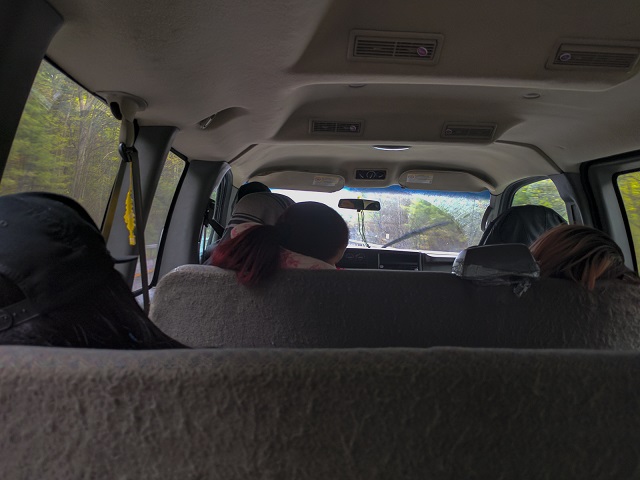 After their visit on May 13, passengers sleep in the van back to New York City from Altona. The ride back is expected to take up to 8 hours. (Photo: Ese Olumhense)
After their visit on May 13, passengers sleep in the van back to New York City from Altona. The ride back is expected to take up to 8 hours. (Photo: Ese Olumhense)
Most have lugged swollen black garbage bags and fraying pushcarts full of favorite foods and clothes to this point, but some items are cheaper and easier to get at Walmart: a steak fajita mix popular with those locked-up at Altona, white socks and undershirts, sweet peppers.
Each of their bags and carts holds 35 pounds of items, give or take: the total monthly weight DOCCS permits for any packages destined for those on the inside. Loveless, a visit veteran, says she now knows the correct weight by sight.
Now inside Altona’s tiny “hospitality center,” just after 6 am, the women begin sign-in, checking in their packages and making impassioned cases before the site’s officers as to why their cans of seasoned tuna and mesh shorts should be admitted. Most are unsuccessful, forced then to stash contraband sausage links and bath towels in lockers provided to them.
Guests then prepare for visits, ducking into a pair of bathrooms to prep and prime. Sweatsuits are swapped for form-fitting (but still DOCCS-appropriate) blouses and jeans. Hair is brushed down from scarves and ponytails, make-up hastily yet carefully applied. Jewelry. Perfume.
It’s now 8 am, and visiting hours have begun. Before guests can access the visiting room, IDs are scanned, and visitors photographed. Photographs, taken every time, are checked in a facial recognition database, officers say, to make sure visitors are who they say they are. (Morpho, the French multinational company that created the facial recognition system DOCCS uses, has also partnered with the FBI in the past to develop its facial recognition programs.)
But despite its use in DOCCS facilities, the software is not described in the copy of the department’s handbook given to Truthout by a department spokesperson. Instead, prospective visitors are told their photograph will be taken for the “visitor identification system.”
The software works slowly on this day, delaying the first few guests, including Loveless. But after a few tries, she is cleared. The grandmother must then remove her bra to walk through a metal detector in order to prove that she’s only wearing an underwire and not smuggling in any prohibited items. Only then are they allowed up to the visiting room to see Loveless’s son — a moment she calls the “highlight” of the entire process, the one thing making it all worth it.
“When it’s your kids, it don’t even matter,” Loveless said of the trip. “I walk through mountains for mine.”
And though some state politicians are trying legislate paths around the “mountains” Loveless describes, she is hesitant to get her hopes up. For the foreseeable future, she plans to continue to put in the time, energy and money necessary to maintain contact with incarcerated members of her family.
“I have to hold my family together,” Loveless said. “If I don’t hold my family together, I won’t have a family.”
Join us in defending the truth before it’s too late
The future of independent journalism is uncertain, and the consequences of losing it are too grave to ignore. To ensure Truthout remains safe, strong, and free, we need to raise $43,000 in the next 6 days. Every dollar raised goes directly toward the costs of producing news you can trust.
Please give what you can — because by supporting us with a tax-deductible donation, you’re not just preserving a source of news, you’re helping to safeguard what’s left of our democracy.